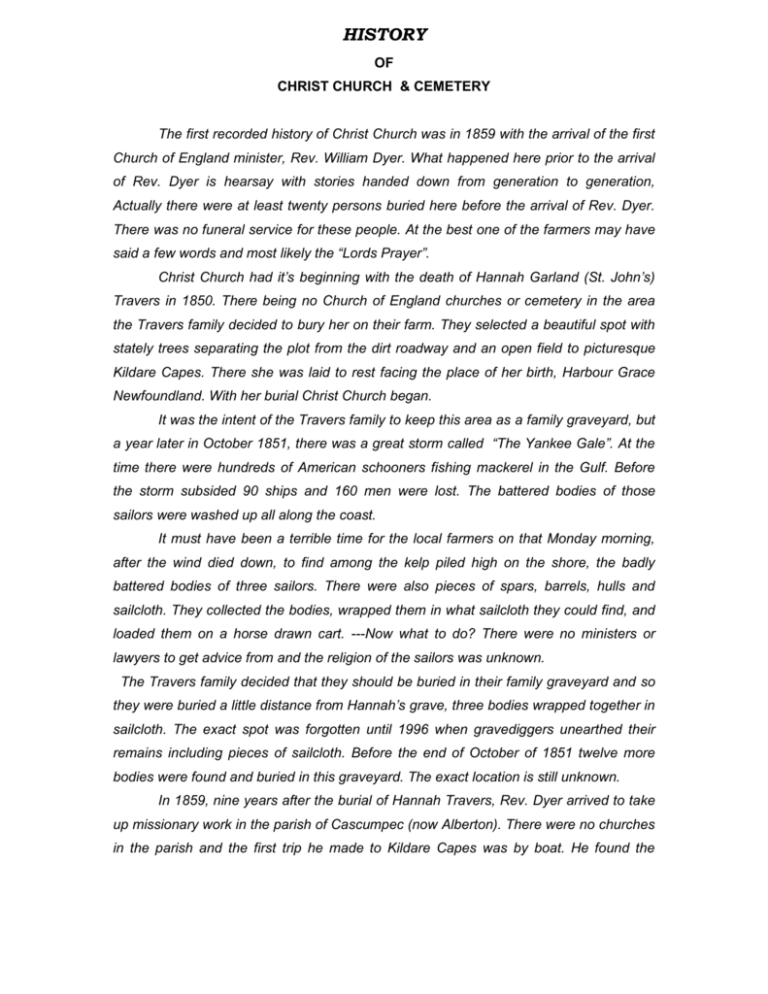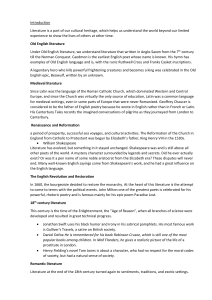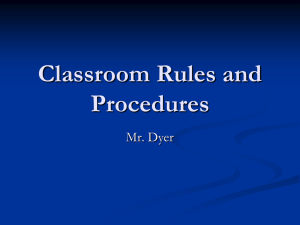File - Christ Church Kildare Capes, PEI
advertisement

HISTORY OF CHRIST CHURCH & CEMETERY The first recorded history of Christ Church was in 1859 with the arrival of the first Church of England minister, Rev. William Dyer. What happened here prior to the arrival of Rev. Dyer is hearsay with stories handed down from generation to generation, Actually there were at least twenty persons buried here before the arrival of Rev. Dyer. There was no funeral service for these people. At the best one of the farmers may have said a few words and most likely the “Lords Prayer”. Christ Church had it’s beginning with the death of Hannah Garland (St. John’s) Travers in 1850. There being no Church of England churches or cemetery in the area the Travers family decided to bury her on their farm. They selected a beautiful spot with stately trees separating the plot from the dirt roadway and an open field to picturesque Kildare Capes. There she was laid to rest facing the place of her birth, Harbour Grace Newfoundland. With her burial Christ Church began. It was the intent of the Travers family to keep this area as a family graveyard, but a year later in October 1851, there was a great storm called “The Yankee Gale”. At the time there were hundreds of American schooners fishing mackerel in the Gulf. Before the storm subsided 90 ships and 160 men were lost. The battered bodies of those sailors were washed up all along the coast. It must have been a terrible time for the local farmers on that Monday morning, after the wind died down, to find among the kelp piled high on the shore, the badly battered bodies of three sailors. There were also pieces of spars, barrels, hulls and sailcloth. They collected the bodies, wrapped them in what sailcloth they could find, and loaded them on a horse drawn cart. ---Now what to do? There were no ministers or lawyers to get advice from and the religion of the sailors was unknown. The Travers family decided that they should be buried in their family graveyard and so they were buried a little distance from Hannah’s grave, three bodies wrapped together in sailcloth. The exact spot was forgotten until 1996 when gravediggers unearthed their remains including pieces of sailcloth. Before the end of October of 1851 twelve more bodies were found and buried in this graveyard. The exact location is still unknown. In 1859, nine years after the burial of Hannah Travers, Rev. Dyer arrived to take up missionary work in the parish of Cascumpec (now Alberton). There were no churches in the parish and the first trip he made to Kildare Capes was by boat. He found the beginning of a building at the Travers graveyard. He pushed the local farmers and had them complete the church in two years. The church was consecrated in 1866. Mary and Jane Travers gave the graveyard property, an area of about two acres to the church, but did not make out a deed for the transfer of the property. This became a problem one hundred years later when the property changed hands. Finally, the adjoining property was purchased by Dr. Robert Borgman of North Carolina and he had a proper deed drawn up. During the building of the church Rev. Dyer held services at the Kildare Capes Schoolhouse No. 29, about a mile and a half north of here. The building still exists and is now a residence. There is story about the first church being shifted on it’s foundation by a strong gust of wind so that it would face directly east and west as all Church of England churches should. From the records it would appear that this could have been during the great storm of 1873. On August 18, 1923 the church burned to the ground. Some say it was hit by lightning and others say it started by a spark from someone smoking, as they were doing some work on the church at the time. The only items saved were some communion vessels and the organ. The organ had been a gift from Jane Travers but she never heard it played, She died the day it arrived and it was played for the first time at her funeral. The organ still exists and is in a local farmhouse. A year later the members of the church purchased the Methodist church in Montrose which was not being used and hauled it by horse and capstan, a distance of about five miles, to this site and mounted it on the same foundation. The first service held in this building was on December 12 1924. The church was very active up to the beginning of WW2 when most of the young people left and very few returned. The last local member passed away in 1995. But, there is a vibrant group of summer residents, of various denominations, from as far away as North Carolina, Connecticut, Nova Scotia and New Brunswick that support this church and parish. We have an evening service every Sunday evening at 7 PM, from mid-June to mid-September. After the service we meet at one of the cottages for coffee and a social hour. Why not come and join us?









